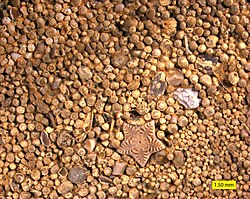Carbonate rock

Carbonate rocks are a class of
Carbonate rocks are also crucial components to understanding geologic history due to processes such as diagenesis in which carbonates undergo compositional changes based on kinetic effects.[2] The correlation between this compositional change and temperature can be exploited to reconstruct past climate as is done in paleoclimatology. Carbonate rocks can also be used for understanding various other systems as described below.
Limestone
Calcite

Aragonite
Compared to calcite, aragonite is less stable and more soluble,[6] and can thus be converted to calcite under certain conditions. In solution, magnesium ions can act as promoters of aragonite growth as they inhibit calcite precipitation.[7] Often this inhibited precipitation occurs in biology where organisms aim to precipitate calcium carbonate for their structural features such as for skeleton and shells.
Dolostone
The discovery of dolomite rock, or dolostone, was first published in 1791[8] and has been found across the Earth's crust from various different time periods.[9] Because the rock is made of calcium, magnesium, and carbonate ions, the mineral crystalline structure can be visualized similar to calcite and magnesite.[10] Due to this composition, the dolomite mineral present in dolostone can be classified by varying degree of calcium inclusion, and occasionally iron, too.[9]
Calcian dolomite
Calcium-rich dolomite, or calcian dolomite, is dolomite which has more calcium than magnesium in its mineral form. This is the most common form of dolomite found naturally and artificially from synthesis.[9] This dolomite, when formed in the oceans, can prove to be metastable.[9] The resultant structure of this mineral presents minimal differences from regular dolomite likely as a result of formation after initial crystal growth.[9]
Ferroan dolomite / ankerite
Iron-rich dolomite, or ferroan dolomite, is doloimite which contains significant trace levels of iron. Due to the similar
Significance
Carbonate rocks are significant for both human understanding of Earth's atmospheric and geologic history, in addition to providing humans with significant resources for current civilizational endeavors such as concrete.
Limestone and concrete
Limestone is often used in concrete as powder due to its cheap cost. During the formation of concrete, however, breakdown of limestone releases carbon dioxide and contributes significantly to the greenhouse effect.[11] There is significant amount of research studying the ideal quantity of calcium carbonate (derived from limestone) in concrete and if other compounds can be used to provide the same economic and structural integrity benefits.[11]
Paleoclimatology from carbonate minerals
Many forms of paleoclimatology exist whereby carbonate rocks can be used to determine past climate. Corals and sediments are well-known proxies for these reconstructions. Corals are marine organisms with calcium carbonate skeletons (rocks) which grow specific to oceanic conditions at the time of growth. Diagenesis refers to the process whereby sediments are being converted to sedimentary rock.[12] This includes biological activity, erosion, and other chemical reactions. Due to the strong correlation between diagenesis and seawater temperature, coral skeletons can be used as proxies for understanding past climate effects.[13] Specifically, the ratio of Strontium to Calcium in the aragonite of coral skeleton can be used, alongside other proxies like oxygen isotopic ratios, to reconstruct climate variability when the coral was growing. This is because Strontium will sometimes substitute for Calcium in the calcium carbonate molecule depending on temperature effects.
Similar to the concept for using compositional changes in coral skeletons as proxies for climate conditions, compositional changes in marine sediments can be used for the same purpose (and more). The changes in trace metal ratios from carbonate minerals found here can be used to determine patterns from parent [carbonate] rocks, too.[14]
See also
References
- S2CID 135198700.
- S2CID 219738220.
- ISBN 0-13-154728-3.)
{{cite book}}: CS1 maint: location missing publisher (link - PMID 35232971.
- .
- ^ "Mystery solved: Why seashells' mineral forms differently in seawater". MIT News | Massachusetts Institute of Technology. 2 March 2015. Retrieved 2023-03-17.
- S2CID 135198700.
- ^ Dolomieu, D.G.D. (1791). "Sur un de pierres très-peu effervescentes avec les acides of phosphorescentes par la collision". Journal de Physique. 39: 3–10.
- ^ S2CID 130135125.
- ISSN 0012-8252.
- ^ S2CID 139571589.
- ^ "Diagenesis - an overview | ScienceDirect Topics". www.sciencedirect.com. Retrieved 2023-03-17.
- S2CID 54844318, retrieved 2023-03-17
- ISSN 0277-3791.
